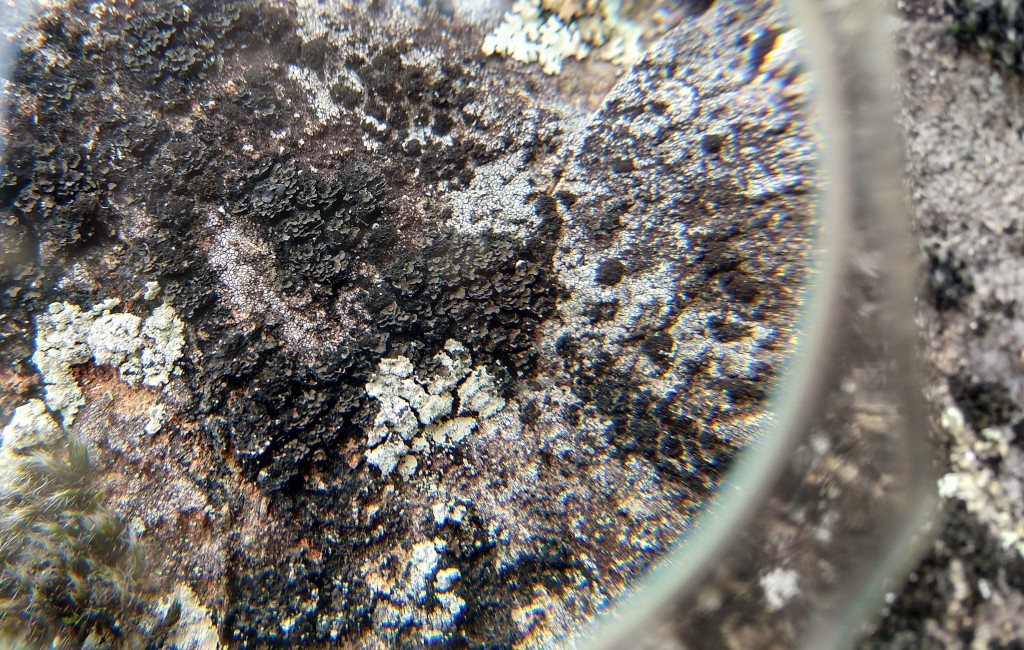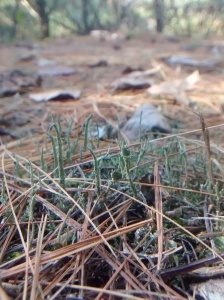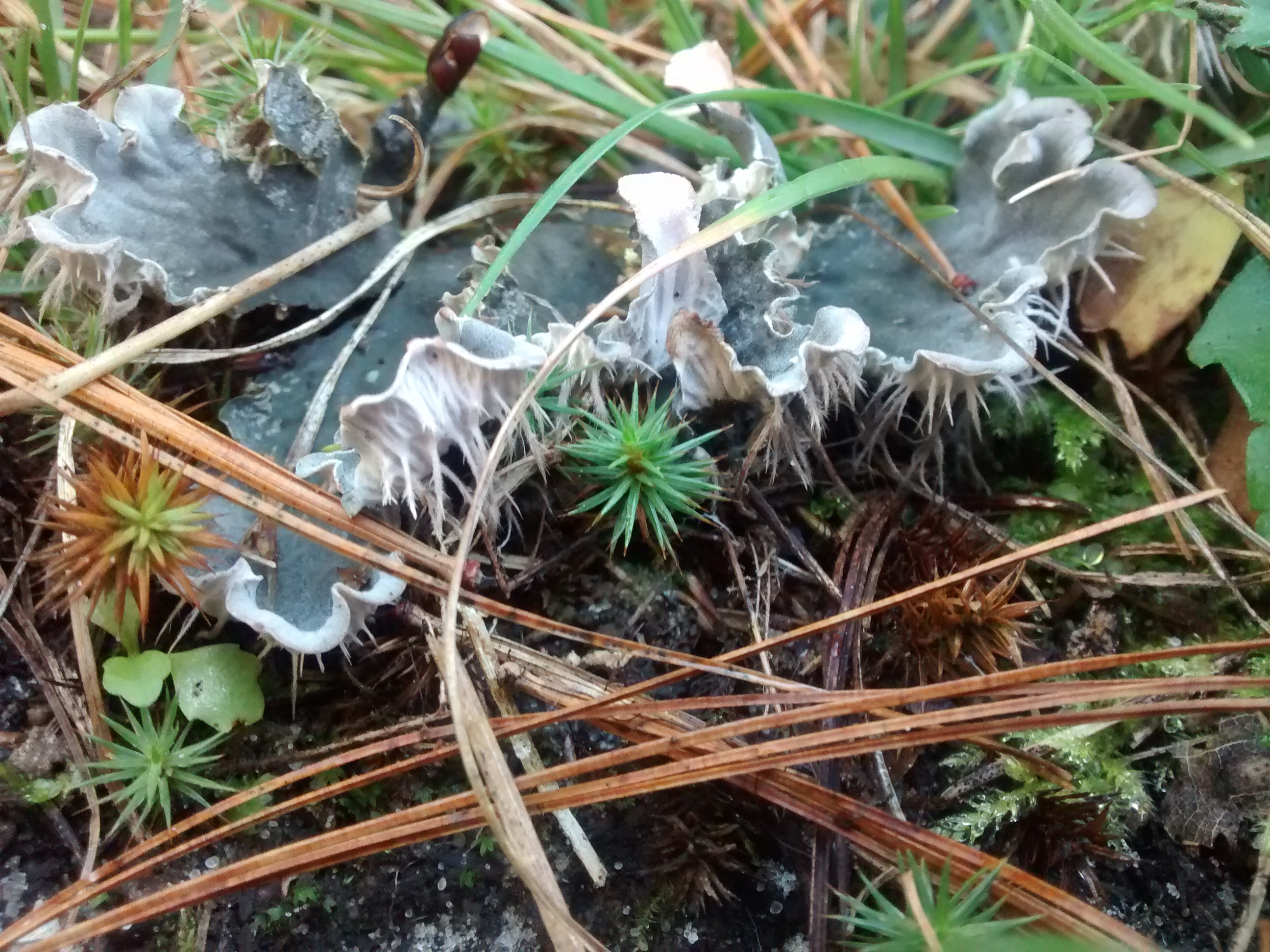lichens
Re-Discovering a New Lichen
What makes a ‘discovery’? Recently a lichen species was discovered, in a digitized collection of lichens that had already been collected and misidentified in the past. The digital databases for scientific collections of field samples allow researchers anywhere in the world to explore samples of lichens, and add new information learned since the time the specimen was collected.

https://www.floridamuseum.ufl.edu/science/rare-lichen-unique-to-florida-may-be-extinct/
I apologize for not providing an image of the new lichen species; I can’t figure out how to manage some of the new aspects of this blog. However, the lichen image above is one of my ‘discoveries’. It is new to me; a discovery made on a slow mosey across a gravelly, cactus and creosote filled flat below Picacho Peak on a warm February evening. Finding a lichen I’ve never seen gives me all the good feelings of discovery; it matters not one tiny bit that others may have already looked at and identified this lichen.

The beautiful cactus above is about two inches tall, seen through a hand lens. This is the first rainbow hedgehog cactus I’ve found and it is a beauty. Unlike many of her kind, there are no pinkish bands of color, only the lace-like white net of spines. Accidentally finding this cactus while looking at lichens in a small rocky outcropping was the best moment of a day filled with excellent sightings and discoveries in a new place. I wonder how many other people wandering very close by on a well used trail have ever seen this tiny beautiful cactus. This was a discovery for me that feels very special.


The black lichen in the above image was a flat dark crust on the rock until I took a look through the hand lens. A multitude of tiny, leafy layers appeared, some with mahogany colors and some with pale edges. Neighbor to the hedgehog cactus, and part of the miniature garden that flourishes at the edge of a busy hiking trail, this lichen and so many others sharing the boulders scattered through the forest are easy to discover by anyone. Slow down, stop for a while and look around. Curiosity is the most effective ‘tool’ for discovering something new.
While idly wandering across gravel flats at Picacho Peak, wondering what might be on seemingly empty ground, I found not only several extremely tiny lichen colonies (see first image), but also found translucent, pale ants making mud tunnels the size of matchsticks, pack rat dens, bird nests, a butterfly new to me, and watched ravens play games with twigs on top of a saguaro. Lichens led me to everything else.

It doesn’t matter what interests you. Everything you find with curiosity becomes new. No matter how many times a familiar lichen is seen, or a bird sighted that you’ve come to overlook because they are so common, there is something new to learn. Discovery doesn’t only happen far away, on Mars or in a distant jungle, it happens in our own backyards and on our favorite walking trails.
I love lichens because their tiny size and inconspicuous ways encourage a slower, more careful observation. Noticing Lichen’s neighbors becomes easy, and before you know it, the forest or meadow is full of color and life you never noticed before. Discovery is not only finding what has never been known by humans, discovery occurs whenever we recognize something amazing or beautiful about the world around us. So next time you are out for a walk, be curious!

Party Time in Lichen Land!

Here in Lichen Land, the tiny but vast community of lichens, bryophytes and fungi are having a party on the Wintergreen Trail. Cladonia and Peltigera, Stereocaulon and Candelariella, Xanthoparmelia and a small crowd of their crustose friends are sporting fancy apothecia (disc or cup that produces spores) in many shapes and colors. The place is decorated in the brightest colors-turquoise, jade green, yellow, white, black, gray, brown, rust, pale blue. A Cladonia first caught my eye; she was fringed and spangled with intricate weavings of pale green, crowned with a russet apothecia/cap perched on her tall slender podetia (stalk). Many other Cladonias waved jade colored cups, some fringed and some smooth edged. The Peltigera rufescens, that not long ago sported velvety gray thallus and dramatic, hooded, vase-like apothecia, now were a bit faded in places. But some of them had grown dozens of tiny, white rhizines (root like structures) from the underside of the thallus (the vegetative part of a lichen that contains the photobiant and mycobiont.

All this elaborate activity goes on within one inch of the ground. A wrong step by a human would destroy many years of growth. But you can join the party; pack a 6x or 10x hand lens, your camera, and just walk into Lichen Site 4. They’ll all be there. Once you step down the two stone steps and turn right, slow down. Stop. Take out the hand lens. Breathe and relax. Even though it’s a party down there, we need to slow down to join up with the Tiny Ones.
Have you ever hunted for 4-leaf clovers? Use the same type of gaze and attitude; you’ll be more successful with lichens because there are so many of them, you can’t miss them. Once a few are seen on the pine needle covered ground you will start to see the stalk-like podetia everywhere. Get down close to them, use your hand lens held close to your eye, then move closer or farther from the lichen to focus, keeping the lens close to your eye.
At ground level the elaborate, fringed structures make a fairyland scene. A few weeks ago, the podetia were straight and smooth pointed stalks. Now they sport cups, caps and fringes. The thallus (the leafy part) may have rhizines, brighter color and also more elaborate shapes. There are many very tiny lichen growing among the taller ones so be careful where you step! It truly is a forest in miniature, with a canopy, mid layer and ground layer of plants and animals.

There are several types and species of lichen sharing Cladonia’s forest. Peltigera sp. has been introduced earlier, but there are many more lichen here. On the edge of the narrow pathway, rocks with lichens barely discernible in the summer now are alive with color and texture. These are crustose lichens, and there are quite a few species here. Many


species of crustose lichen on the rocks at this site have produced apothecia. Look for dark spots in the light colored crustose lichen body. Most of the lichen on these rocks are white, gray, or blue-gray. There also are some black crustose lichen here. Look closely with your hand lens to check for apothecia on the black lichen; they are hard to see. How many different species of lichen can you find? These can be very hard to identify without a high powered microscope to see details, and chemicals to test certain reactions lichens may have. At this time, the Lichen Hunters are simply recognizing these are ‘crustose’ forms.
On the low, sandy cliff (the cliff is 2-3 feet high) at the top of this area, the walls have been decorated in turquoise, green and white. The colors are bright and clear. In the shadows under the rocky overhang, the gauzy, lacy texture of lichen mixed with moss, spider webs and falling grains of sand make a confusing scene. What is lichen, and what is sand grains, or spider webs?

As the sunbeams illuminated strands of turquoise and green against the dark recesses it seemed to be an endless mass of tangled threads. Much of the lichen here is probably a Stereocaulon sp. commonly called ‘Rock Foam’. There are several species, some of which, in the arctic, are food for caribou during famine.

Pixie Foam, a miniature Stereocaulon species, often grows where there is a high concentration of metals in the rock. Lichens are used all over the world to prospect for minerals by analyzing the mineral content of the lichen thallus. (From ‘Lichens of the North Woods).
How many species of lichens can you sort out, under the sandy ledge? There are also mosses, ferns and fungi here. How many different life forms can you find, of any kind? This is a rich, active place, yet we know almost nothing about the lives here, or what their place in the world might be.
This visit to Lichen Land left me feeling as if I’d crashed a party. The last time I was here, the lichen were growing podetia but were much smaller. Today I crossed the threshold of two stone steps into their world, and it had changed dramatically. Colors were brilliant, forms were elaborate; the lichens seemed more alive! They didn’t seem like the same lichens I’d seen earlier. It was quiet, but I felt there was music and shouting and dancing going on, in a tiny way. It felt like a party.
As I walked away I thought about how the earth, rock, sand, and trees, each have a community of lichen. They are not plants, they are not animals; they are simply something else. What do they weave for the web of life in the world as we know it? Why do they cover such a large part of the earth’s land surface? There are over a hundred species of lichens on the base of the trees in the Kickapoo Valley Reserve. We don’t know how many different ones are in the canopy, or the soil or on the rocks here. Everything in Nature has a place and a purpose. The Lichen Hunters are exploring what that might be for the lichens in the Kickapoo. Come on out for a walk in the woods and help us learn about the Tiny Ones.

